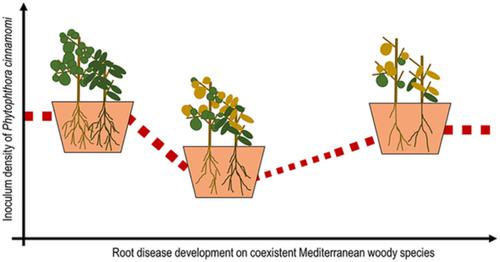当前位置:
X-MOL 学术
›
Ann. Appl. Biol.
›
论文详情
Our official English website, www.x-mol.net, welcomes your
feedback! (Note: you will need to create a separate account there.)
Coexistent Mediterranean woody species as a driving factor of Phytophthora cinnamomi infectivity and survival
Annals of Applied Biology ( IF 2.2 ) Pub Date : 2020-05-05 , DOI: 10.1111/aab.12599 Maria C. Gómez 1 , Mario González 2 , Lorena Gómez‐Aparicio 1 , Maria S. Serrano 1
Annals of Applied Biology ( IF 2.2 ) Pub Date : 2020-05-05 , DOI: 10.1111/aab.12599 Maria C. Gómez 1 , Mario González 2 , Lorena Gómez‐Aparicio 1 , Maria S. Serrano 1
Affiliation

|
The long‐term conservation of Mediterranean mixed oak forests is seriously threatened by the massive mortality of Quercus suber caused by the exotic pathogen Phytophthora cinnamomi. This species frequently grows in mixed forests under natural conditions, but nothing is known about how its level of disease might be altered by the diversity and identity of coexisting neighbours varying in susceptibility to the exotic pathogen. Here we analysed the individual and combined effects of Q. suber and the main coexisting tree species (Quercus canariensis and Olea europaea subsp. europaea var. sylvestris) in mixed forests of southern Spain on the production of infective and survival spores of P. cinnamomi. Through in vitro experiments, it was demonstrated that mixtures of Q. suber and Q. canariensis highly stimulated the production of P. cinnamomi zoospores in comparison with both species in monocultures. Olea europaea did not stimulate zoospore production. Under controlled conditions, the initial and final densities of inoculum in soil planted with monocultures of O. europaea and Q. canariensis did not differ. However, inoculum densities significantly decreased along the experiment in Q. suber mixtures with O. europaea and Q. canariensis. Phytophthora cinnamomi was able to infect and cause root rot symptoms on all tree species, including O. europaea var. sylvestris. We concluded that mixed stands of Q. suber and Q. canariensis are able to stimulate P. cinnamomi infectivity and survival much more than monospecific stands, and consequently under favourable conditions for root disease development, the coexistence of Q. suber and Q. canariensis might exacerbate Mediterranean forests decline. This study also constitutes the first report of O. europaea var. sylvestris as host and inductor of P. cinnamomi sporulation under controlled conditions.
中文翻译:

地中海木本物种共存为疫霉菌感染和生存的驱动因素
由于外来病原体疫霉菌引起的枯死栎的大量死亡,严重威胁了地中海混交栎林的长期保护。该物种经常在自然条件下在混交林中生长,但是对于其病害水平如何因对异国病原体的敏感性不同而共存的邻居的多样性和身份如何改变一无所知。在这里,我们分析了个人和综合影响Q.苏伯和主共存树种(栎海枣和油橄榄亚种油橄榄变种樟子松)在西班牙南部的混交林中对肉桂的传染性和存活孢子的产生。通过在体外实验中,已证实的混合物Q.苏伯和Q.海枣高度刺激生产的肉桂疫霉的游动孢子与在单一培养两个物种的比较。油橄榄没有刺激游动孢子的产生。在受控条件下,欧洲油。和加拿大油。的单一培养物种植的土壤中接种物的初始和最终密度没有差异。然而,随着实验的进行,Q.suber混合物中的接种物密度显着降低。O.europaea和Q.canariensis。肉桂疫霉能够感染并引起所有树木物种的根腐病症状,包括欧洲油松。樟子松。我们得出的结论是,马苏木和卡纳里克苏木的混合林分比单特异性林木更能刺激肉桂拟南芥的感染力和存活率,因此,在根部疾病发展的有利条件下,马苏木和卡纳里克林共存可能加剧了地中海森林的衰退。这项研究也构成了欧洲油菜的第一份报告。樟子松为可控条件下肉桂肉桂孢子形成的宿主和诱导剂。
更新日期:2020-05-05
中文翻译:

地中海木本物种共存为疫霉菌感染和生存的驱动因素
由于外来病原体疫霉菌引起的枯死栎的大量死亡,严重威胁了地中海混交栎林的长期保护。该物种经常在自然条件下在混交林中生长,但是对于其病害水平如何因对异国病原体的敏感性不同而共存的邻居的多样性和身份如何改变一无所知。在这里,我们分析了个人和综合影响Q.苏伯和主共存树种(栎海枣和油橄榄亚种油橄榄变种樟子松)在西班牙南部的混交林中对肉桂的传染性和存活孢子的产生。通过在体外实验中,已证实的混合物Q.苏伯和Q.海枣高度刺激生产的肉桂疫霉的游动孢子与在单一培养两个物种的比较。油橄榄没有刺激游动孢子的产生。在受控条件下,欧洲油。和加拿大油。的单一培养物种植的土壤中接种物的初始和最终密度没有差异。然而,随着实验的进行,Q.suber混合物中的接种物密度显着降低。O.europaea和Q.canariensis。肉桂疫霉能够感染并引起所有树木物种的根腐病症状,包括欧洲油松。樟子松。我们得出的结论是,马苏木和卡纳里克苏木的混合林分比单特异性林木更能刺激肉桂拟南芥的感染力和存活率,因此,在根部疾病发展的有利条件下,马苏木和卡纳里克林共存可能加剧了地中海森林的衰退。这项研究也构成了欧洲油菜的第一份报告。樟子松为可控条件下肉桂肉桂孢子形成的宿主和诱导剂。











































 京公网安备 11010802027423号
京公网安备 11010802027423号